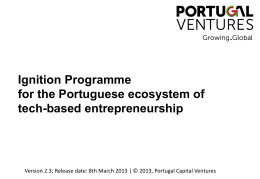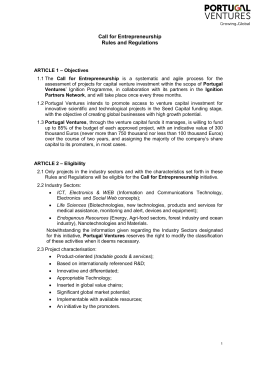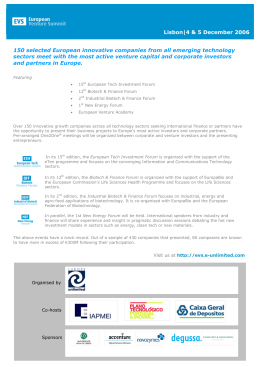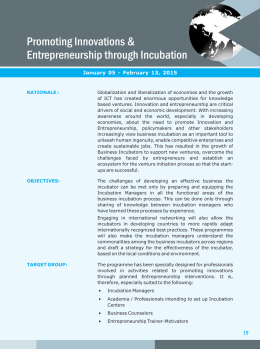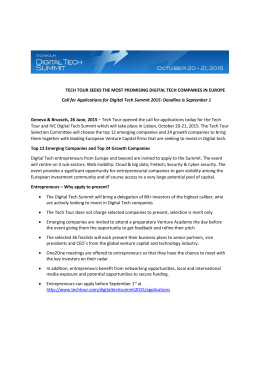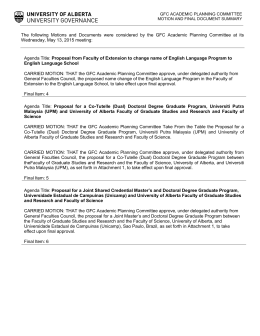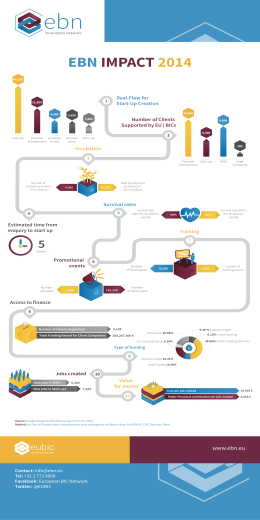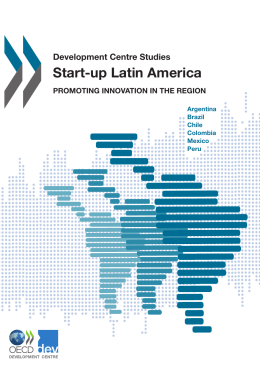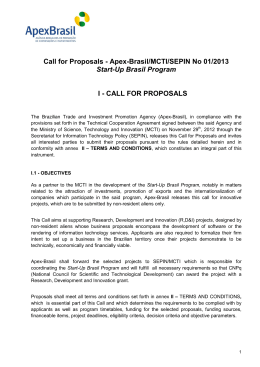This is the author’s version of a work that was submitted/accepted for publication in the following source: Davidsson, Per & Gordon, Scott R. (2012) Much ado about nothing? The surprising persistence of nascent ventures through the global financial crisis. In The Joint ACERE-DIANA International Entrepreneurship Conference, 31 January – 3 February 2012, University of Notre Dame, Fremantle, WA. This file was downloaded from: http://eprints.qut.edu.au/48714/ c Copyright 2012 [please consult the authors] Notice: Changes introduced as a result of publishing processes such as copy-editing and formatting may not be reflected in this document. For a definitive version of this work, please refer to the published source: This is the author’s version of a work that was submitted/accepted for publication in the following source: Davidsson, Per & Gordon, Scott R. (2012) Much ado about nothing? The surprising persistence of nascent ventures through the global financial crisis. In The Joint ACERE-DIANA International Entrepreneurship Conference, 31 January – 3 February 2012, University of Notre Dame, Fremantle, WA. This file was downloaded from: http://eprints.qut.edu.au/48714/ c Copyright 2012 [please consult the authors] Notice: Changes introduced as a result of publishing processes such as copy-editing and formatting may not be reflected in this document. For a definitive version of this work, please refer to the published source: MUCH ADO ABOUT NOTHING? THE SURPRISING PERSISTENCE OF NASCENT VENTURES THROUGH THE GLOBAL FINANCIAL CRISIS Davidsson P1, Gordon S1 1 Australian Centre for Entrepreneurship Research, QUT Business School, Queensland University Of Technology Submitting Author Contact Information: Per Davidsson Australian Centre for Entrepreneurship Research, QUT Business School, Queensland [email protected] 1 Much Ado about Nothing? The Surprising Persistence of Nascent Ventures through the Global Financial Crisis Abstract Using the Global Financial Crisis as a natural experiment, we investigate how a major macroeconomic crisis affects nascent (i.e., pre-operational) ventures. We hypothesize adverse effects on behaviors, behavioral plans, and expectations for the future, and that these effects would be more pronounced in ventures that are more innovative and/or more relying on loan funding. Overall, we find very limited support for our hypotheses. Our conclusion is that the main reason for the surprising absence of detrimental effects is that a large majority of nascent ventures are mostly affected by a relatively narrow, immediate task environment rather than directly by the fluctuations of the macro-economy. Introduction How does a sharp economic downturn like the Global Financial Crisis (GFC) affect entrepreneurial activity? A careful reading of the extant literature gives a fair idea of how an external shock like the GFC can affect the number and composition of independent business start-ups that are either attempted or completed in an economy. However, evidence is lacking on how the journey from attempt to completion (or termination) of the business creation process is influenced. To the best of our knowledge there exists no prior research studying how the onset of a dramatic economic downturn makes nascent entrepreneurs adjust their aspirations, expectations, or behavior. Such research is needed in order to develop a better understanding of how aggregate changes in the start-up activity are derived. Using the unique situation of a natural experiment this article investigates the effects of a sharp economic downturn on on-going business start-ups. The onset of the GFC occurred in the middle of the second round of data collection for a large, longitudinal study of nascent ventures. This should make it possible to distinguish genuine effects of GFC from other influences over time. We pay particular attention to more ambitious and innovative ventures. Economic crisis and business start-up activity: What we know Two related literatures shed some light on the likely effects of an event like the GFC on the creation of new businesses. One of these focuses on the effects of unemployment whereas the other addresses business cycle downturns more broadly. At first glance both appear to give a mixed and confusing picture. For example, a very recent study of effects of the GFC suggests that business registrations fell in most countries studied, and more so in countries that were more severely affected (Klapper & Love, 2011). Similarly, studying effects of the sharp downturn in Sweden in the early 1990s, Davidsson, Lindmark and Olofsson (1999) found that job creation by new, independent firms fell significantly, albeit less so than job creation by other parts of the business population. However, results of the Global Entrepreneurship Monitor (GEM) surveys do not reveal a sharp or general decline in the proportion of the adult population engaging in on-going start-up efforts or independent firms of young age (Bosma & Levie, 2010; Kelly, Bosma, & Amoros, 2010). Studying the Asian Financial Crisis in the late 1990s, Paulson and Townsend (2003) even found that entrepreneurial activity, measured as the proportion of households operating a business, increased sharply in Thailand as a result of the crisis. Similarly, results from the literature focusing on unemployment and new firm formation suggests that depending on the specific context (and method) of the study the relationship may come out positive, negative, or neutral (Blanchflower, 2000; Evans & Leighton, 1989; Moore & Mueller, 2002). A possible explanation is that high levels of unemployment reflect 2 poor demand conditions as well as it means that more people have reason to find alternative ways to support themselves. This suggests that depending on which effect is stronger the total number of start-ups or start-up attempts may turn in either direction. However, a closer examination of the evidence suggests strong effects on the type of individuals and type of businesses that make up that aggregate figure. Studies finding negative overall effects give more weight to start-ups of “higher quality”. Klapper and Love (2011) include only limited liability companies and thus exclude the large number of simpler businesses that are formed as partnerships or sole proprietorships. Davidsson et al. (1999) focused on the aggregate job contributions of start-ups rather than on their raw numbers, finding the marked decline that is to be expected should the proportion of higher-ambition start-ups drop. While reporting an increase in total numbers, Paulson and Townsend (2005) also provide direct evidence of the crisis leading to large numbers of simple start-ups with very low initial investment and thus to a completely different start-up cohort than that being created before the crisis. Similarly, GEM data show that the GFC was associated with a clear downturn in perceptions of opportunity while the proportion of necessity-based start-ups increased (Kelly, et al., 2010). Thus, overall the evidence suggests that the immediate effects of a financial crisis are to reduce the numbers of “higher-ambition” and “higher-potential” start-ups, while the total numbers may develop in either direction. Hypothesized effects of an economic crisis on nascent ventures Immediate, behavioral responses Regrettably, the prior literature does not provide any direct evidence on how nascent ventures, i.e., on-going but not yet completed start-up attempts are affected by the onset of a major economic crisis. A plausible starting assumption is that most founders will perceive the change in conditions, and that this will be interpreted as a change for the worse: the start-up in being appears less promising than it did prior to the onset of the crisis. Hirschman (1970) developed some seminal ideas on “exit” vs. “voice” as generic responses to decline in firms, organizations or states. In a nutshell, Exit-Voice Theory holds that stakeholders of an organization (e.g., employees in or customers of a business; citizens of a nation) have two possible courses of action when they perceive that the organization is undergoing a change that decreases its benefit to the member: they can exit (withdraw from the relationship) or they can voice their discontent through grievance or complaints in the hope that this will lead to improvements. Prior research in other settings has demonstrated that economic climate can affect these responses (Chia, Landau, & Ong, 2000). Like consumers, employees or citizens, business founders can choose to exit, i.e., they can terminate the venture when they learn that its prospects are probably not as great as previously believed. Accordingly, our first hypothesis is: H1: The onset of a major economic crisis makes founders of nascent ventures more likely to terminate the venture creation attempt. Hirschman’s (1970) alternative response mode – voice – is different for business founders compared to consumers, employees or citizens. Being the principal decision makers of the ventures they are trying to establish, business founders do not have a micro-level counterpart to whom they can express discontent with any hope of remedial action resulting. Voice on the aggregate level would mean voting out a government or influencing it via political lobbying. In this regard, founders of nascent ventures are a relatively small group in a transient role, and typically they are not well connected with each other. Consequently, they do not collectively constitute a strong political force. On the positive side, they are not restricted to merely giving voice to their disappointment in the hope that powerful others would initiate 3 the change they are seeking. Instead, equipped with more autonomy than employees (Hundley, 2001) business founders can take action themselves in order to compensate for the setback.Thus, if they do not terminate, a likely response for business founders would be to work harder. H2: The onset of a major economic crisis makes continuing founders of nascent ventures work longer hours to counteract the negative consequences of the external shock. Responses in behavioral plans Prior research suggests that more ambitious start-ups undergo more complex start-up processes and may be more difficult to get operational (Davidsson & Gordon, 2011). A general finding from psychology is that aspirations tend to adjust to the attainable (Simon, 1959). Therefore, one likely response to crisis is to lower the ambition for the venture. Stated differently, founders of nascent ventures may adjust downward the (projected) performance threshold required for them to find continued involvement in the business worthwhile (Gimeno, Folta, Cooper, & Woo, 1997). One manifestation of this would be to reduce aspirations as to the future size of the business, making it less growth-orientated. Based on the data available we test this general idea through the following manifestations: H3: The onset of a major economic crisis makes continuing founders of nascent ventures less growth-orientated as reflected in: a. an increased likelihood of reducing the future size aspiration for the venture, and b. a reduced attraction to entering foreign markets. The credit crunch resulting from the GFC is a major reason for suspecting adverse effects on on-going start-up efforts. However, many business founders use frugal approaches to making progress through bricolage (Baker & Nelson, 2005) and financial bootstrapping (Winborg & Landström, 2001). Accordingly, prior research has demonstrated that many nascent ventures achieve operational status based on very limited investments (Kim, Aldrich, & Keister, 2006). One plausible response to the downturn is to increase the reliance on such approaches, thus bypassing the need for external finance. This leads to our fourth hypothesis: H4: The onset of a major economic crisis makes continuing founders of nascent ventures more likely to try to set up their business without reliance on external funding. Responses in the form of cognitive adjustment Even in the absence of actual or planned behavioral responses, a sharp economic downturn is likely to affect business founders’ perceptions of the future. Business founders have been found to be optimistic both as regards the longer term survival probability of their own venture and that of “other ventures like theirs” – the former more so than the latter (Cooper, Woo, & Dunkelberg, 1988). The onset of the GFC was arguably a rather strong and clear signal that economic conditions for the foreseeable future had worsened. Therefore, we expect founders of nascent ventures to adjust downward their estimated survival probabilities, both for their own venture and for other start-ups. H5: The onset of a major economic crisis makes continuing founders of nascent ventures adjust downward their estimate of the survival probability of their venture. H6: The onset of a major economic crisis makes continuing founders of nascent ventures adjust downward their estimate of the survival probability of other nascent ventures. 4 Loan finance and innovativeness as moderators As already noted above, the credit crunch is often pointed out as a major reason to expect negative effects of economic downturn on business start-up activity (e.g., Klapper & Love, 2011). This suggests that start-ups that are more dependent on external debt funding may be harder hit by events such as the GFC. Above we also reviewed evidence suggesting that it is predominantly the numbers of successfully started “higher-ambition” and “higher-potential” start-ups that declines in economic downturns. Greater need for credit may be one reason for this. Another aspect of being “high potential” is the new venture’s level of innovativeness. While all start-ups have to deal with issues of lacking legitimacy and liabilities of newness (Aldrich & Auster, 1986) these are particularly pronounced for innovative new ventures (Aldrich & Fiol, 1994). In the highly uncertain times created by a sudden economic crisis the extra hurdles to gaining acceptance may be assumed to hit innovative firms even harder. Thus, we expect all of the effects of the economic crisis to be more pronounced for innovative firms and for firms with greater dependence on external debt finance. These two characteristics are often related, and indicative of a “higher potential” venture. We express these expectations in the two final, summary hypotheses: H7: The onset of a major economic crisis more strongly affects nascent ventures relying on external debt finance. Therefore, having external debt moderates each of the previously discussed effects in such a way that it indicates a more adverse effect of the crisis. H8: The onset of a major economic crisis more strongly affects nascent ventures that are innovative. Therefore, the venture’s degree of novelty moderates each of the previously discussed effects in such a way that it indicates a more adverse effect of the crisis. Method The empirical setting: GFC in Australia As will be detailed below our data collection assumes respondents have been affected by the GFC if they were interviewed in the nine months following the collapse of Lehman Brothers on September 15, 2008. It has been concluded in retrospect that Australia was far less hit by the GFC than were the US and Europe (Le Queux & Waring, 2010). However, this was not at all clear at the time of our data collection. For example, the Australian dollar fell sharply (XE Currency Converter, 2011) as did business confidence (National Australia Bank, 2011). Business registration turned down, and exits increased (Australian Bureau of Statistics, 2009). There is no doubt that at the time of our post-GFC interviewing, economic actors in Australia were surrounded by a message of drastic economic downturn. Thus, the empirical setting should be suitable for testing our hypotheses. Sample and design The data used for testing our hypotheses are from the Comprehensive Australian Study of Entrepreneurial Emergence (CAUSEE). Adult members of 30,105 Australian households, selected through random digit dialing, were screened for status as nascent entrepreneurs (NE) using techniques that have been carefully refined through prior projects (Reynolds, 2009). A total of 625 individuals qualified as NEs and also completed a comprehensive, 40-60 minutes long telephone interview (W1) about the emerging venture, either directly or by later appointment. As close as possible to 12 months after the first interview, respondents were recontacted for an equally comprehensive follow-up interview (W2). The number of respondents in W2 is 493. This is the effective sample size for our termination analysis. Of the W2 respondents, 337 were still actively involved in the start-up and could thus meaningfully participate in the full W2 survey. Thus, 337 cases is the (maximum) sample 5 size for our tests of hypotheses pertaining to outcomes other than termination. See Davidsson, Steffens and Gordon (2011) for further details on CAUSEE and its sample. The W2 interviews took place from July 24, 2008 to June 11, 2009. The Lehman Brothers collapse occurred on September 15, 2008. This is what creates a natural experiment, as sizeable parts of the sample are interviewed before and after this date. Operationalization – dependent variables Termination. Termination is a dichotomous variable where “0” is recorded for cases where the venture is not yet abandoned and “1” is recorded when the venture has been terminated (138 cases) according to double-checked responses. Work Effort. Change in work effort is measured as the Wave1-Wave2 difference in hours in response to the question “How many hours per week do you [and all other owners combined] currently work for this business?” For the logistic regression version of our analysis (see below) this variable was dichotomized with “1” meaning an increase in effort. Venture size preference. In both W1 and W2 the respondents were asked “Which of the following two statements best describes your preference [/the preference your owner team has/] for the future size of this business: I [/We/] want this business to be as large as possible, or I [/we/] want a size I [/we/] can manage myself [/ourselves/] or with a few key employees?” Change in size preference is calculated as a dichotomous variable where “1” means a downward shift and “0” means no such shift. Perceived international market attraction. In both waves, the respondents were asked “How attractive are opportunities for your business in international markets compared to the Australian market? Would you say more attractive; about the same, or less attractive?” Responses were recorded on a 3-point scale from more to less attractive. Decrease in attractiveness was computed as the difference between W1 and W2 assessments. For the logistic regression version of our analysis (see below) this variable was dichotomized with “1” meaning a decrease in attraction to international markets between waves. Self-sufficiency. This variable was computed from one of the “gestation activities” variables reading “Have financial institutions or other people been asked for funds for this new business, do you expect to ask for funds in the future, or is outside financial support not relevant for this new business?”. The response alternatives were “yes”, “no, not yet”, and “no, not relevant to this business”. Increase in self-sufficiency is computed as a dichotomous variable where “1” means a shift to “no, not relevant”. Own survival probability. In each wave the respondents were asked “On a scale of zero to one hundred, what is the likelihood that this business will [still] be operating five years from now, regardless of who owns and operates the firm?” Decreasing probability was computed as W2 estimate minus W1 estimate. For the logistic regression version of our analysis (see below) this variable was dichotomized with “1” meaning a decrease in the estimate of own survival probability between waves. Others’ survival probability. Respondents were asked “In this research we are talking to hundreds of early stage start-ups. If we take one hundred of them at random, how many do you think will still be operating five years from now, regardless of who own and operate them?” Decreasing probability was computed as W2 estimate minus W1 estimate. For the logistic regression version of our analysis (see below) this variable was dichotomized with “1” meaning a decrease in estimate of others’ survival probability between waves. Operationalization – independent variable; controls, and interaction terms GFC. Post- vs. pre-GFC is a dichotomous variable reflecting whether in W2 the respondent was interviewed before (0) or after (1) the onset of GFC September 15, 2008). In 6 the analysis of termination, there are 181 pre-GFC and 312 post-GFC cases. In the remaining analyses the corresponding (maximum) numbers are 121 and 216, respectively. Major loan funding. In W1 the respondents were asked for a range of possible funding sources whether the source had not been used at all; as a minor funding source, or as a major funding source. The latter was defined as 20 percent or more of total funding needs. We computed a dichotomous variable with value “1” if one or more sources of external debt were rated as major sources and value “0” for all other cases. The use of personal credit card debt was not included in the calculation of major loan funding. Novelty. Our measure of novelty (or height of innovation) is based on the scale developed and thoroughly examined by Dahlqvist and Wiklund (2011). We adapted the measure to the nascent venture context and expanded it to cover four dimensions of innovation of new firms: a) product/service novelty, b) process novelty, c) marketing methods novelty, and d) novelty in target market selection. The level of novelty for each of these dimensions was assessed as 0 = imitative; 1 = substantial improvement compared with existing offerings in the industry; 2 = entirely new to the industry; 3 = new to the world. The wording was slightly different for the dimension “novelty in target market selection” but retained the same four-level structure. The four dimensions of innovation combine to determine the overall novelty, with a theoretical range from 0-12. Initial development stage. Davidsson and Gordon (2011) note that when a sampling approach such as ours is used the ventures will be variously far progressed when they are interviewed for the first time. In line with their recommendation we control for initial development stage by means of a count variable reflecting the number of “gestation activities” that were already undertaken at W1. Industry. We control for industry effect by means of dummy variables for five broad industry sectors, namely Retail & wholesale; Health, education & social services; Manufacturing & mining; Construction & real estate, and Business services & finance, with “Other” as the reference category. Interaction variables to test hypotheses 7 and 8 were computed by multiplying the relevant terms (GFC * Major loan funding, and GFC * Novelty). As the GFC term is dichotomous, mean-centering was not an issue. Analysis approach and technique Hierarchical logistic regression was used to assess the influence of independent variables on the dichotomized versions of the dependent variables (Hosmer & Lemeshow, 2004). The change in model fit was used to assess the influence of the GFC and interaction terms on the dependents. These effects were assessed by single-tailed tests of statistical significance. In order to confirm the results for direct effects of the GFC on nascent venturing we also analyzed the magnitude of change in all six multi-wave dependent variables using the difference in differences technique. This is a quasi-experimental technique which calculates the average treatment effect in natural experiments such as this. (Meyer, Viscusi, & Durbin, 1995). For this analysis we used the full range of variation available in each DV. Results Table 1 reports the logistic regression results for our behavioral dependent variables while results for behavioral plans and cognitive adjustment are reported in Table 2. The corresponding DID results are reported in Table A2 (Appendix; available from authors on request), where pre- and post-GFC means by interview wave can also be found. With respect to our hypotheses the results for the two analysis approaches are fully consistent. Therefore, while making occasional reference to Table A2 we will here focus on the results from the logistic regressions in Table 1 and Table 2. These tables are organized hierarchically. For 7 each dependent variable we first present a base model with only control variables included. In the next column we add the GFC variable. We then separately present models with each interaction term added. However, to save space we only present the latter models when a statistically significant interaction (moderation) effect is found. The briefest possible summary of our results is that there is a startling absence of support for our hypotheses. Most coefficients relating to our hypotheses are statistically nonsignificant, and some are in the direction opposite to our prediction. Further, the quasi-R2 measures are moderate to low across all analyses. With respect to Termination (H1) the estimated effect is in the direction opposite to what we hypothesized, and non-significant. The same is true for Work effort. Therefore, both H1 and H2 must be rejected. We do not find the expected behavioral effects of the GFC on nascent ventures. Table 1: Logistic regression analyses of immediate behavioral responses to the GFC. Independent variables Constant Retail & wholesale Health, education & social Manufacturing & mining Construction & real estate Business services & finance Novelty Major loan funding Initial development stage GFC GFC * Major loan funding Termination 2.425* (0.013) 1.382 (0.256) 0.662 (0.265) 1.062 (0.870) 1.341 (0.484) 1.047 (0.898) 0.996 (0.930) 0.859 (0.623) 0.896*** (0.000) 2.779** (0.007) 1.372 (0.268) 0.649 (0.245) 1.079 (0.837) 1.351 (0.474) 1.017 (0.962) 0.998 (0.970) 0.864 (0.636) 0.896*** (0.000) 0.798 (0.151) Work effort 2.653* (0.011) 1.353 (0.291) 0.640 (0.228) 1.080 (0.837) 1.359 (0.465) 0.971 (0.935) 0.995 (0.902) 1.380 (0.486) 0.895*** (0.000) 0.897 (0.323) 0.453† (0.097) 1.875 (0.125) 0.902 (0.751) 2.904** (0.003) 0.755 (0.506) 0.431 (0.109) 1.133 (0.734) 0.867** (0.003) 1.394 (0.264) 0.984 (0.386) 2.007 (0.104) 0.904 (0.755) 2.882** (0.004) 0.773 (0.544) 0.437 (0.116) 1.112 (0.774) 0.868** (0.004) 1.399 (0.259) 0.984 (0.412) 0.874 (0.290) n 493 330 Model Χ2 52.831*** 53.891*** 55.576*** 26.997*** 27.305** Log likelihood -266.812 -266.283 -265.44 -214.943 -214.789 Cox & Snell R2 0.102 0.104 0.107 0.079 0.079 2 Nagelkerke R 0.146 0.149 0.153 0.105 0.106 ModelΔ Χ2 1.060 1.685 0.308 Note: Regression parameters expressed as odds ratios, with statistical significance in parentheses (); Two-tailed significance tests used for covariates and one-tailed significance tests used for hypothesized effects; † p < 0.1; * p < 0.05; ** p < 0.01; *** p < 0.001; Non-significant interactions are not reported. 8 Table 2: Logistic regression analyses of changes in behavioral plans and cognitive adjustment to the GFC. Venture size Perceived int. market Own survival Others’ survival Self-sufficiency preference attraction probability probability Constant 0.102*** 0.097*** 2.069 1.774 0.837 1.466 3.027* 3.264* 2.207† 1.858 (0.000) (0.000) (0.141) (0.265) (0.788) (0.582) (0.016) (0.014) (0.063) (0.160) Retail & wholesale 1.199 1.196 1.092 1.084 0.646 0.685 1.423 1.429 0.872 0.853 (0.683) (0.688) (0.815) (0.831) (0.485) (0.550) (0.387) (0.382) (0.685) (0.640) Health, education & social 2.046† 2.059† 0.855 0.878 1.319 1.204 0.721 0.715 1.734 1.763 (0.088) (0.086) (0.692) (0.743) (0.625) (0.751) (0.380) (0.370) (0.151) (0.141) Manufacturing & mining 1.218 1.197 3.002† 2.818 1.002 1.188 0.623 0.640 0.931 0.863 (0.722) (0.747) (0.092) (0.114) (0.998) (0.815) (0.285) (0.316) (0.867) (0.733) Construction & real estate 1.616 1.591 1.038 1.016 1.038 1.314 1.232 1.259 1.004 0.947 (0.436) (0.453) (0.948) (0.978) (0.965) (0.754) (0.727) (0.702) (0.994) (0.916) Business services & finance 0.157† 0.159† 3.857* 3.987* 2.660† 2.442 0.927 0.910 0.900 0.937 (0.077) (0.079) (0.037) (0.033) (0.088) (0.127) (0.858) (0.825) (0.782) (0.866) Novelty 1.050 1.049 1.063 1.059 1.012 1.030 0.960 0.961 0.921† 0.917† (0.440) (0.450) (0.288) (0.327) (0.891) (0.726) (0.449) (0.460) (0.099) (0.086) Major loan funding 0.543 0.541 1.124 1.106 0.641 0.667 1.193 1.202 1.121 1.111 (0.172) (0.169) (0.749) (0.782) (0.502) (0.547) (0.615) (0.603) (0.716) (0.740) Initial development stage 1.018 1.017 1.000 0.998 0.879*** 0.880*** 1.011 1.011 1.007 1.005 (0.485) (0.503) (0.983) (0.936) (0.000) (0.001) (0.629) (0.599) (0.732) (0.818) GFC 1.115 1.365 0.273** 0.857 1.471† (0.375) (0.147) (0.001) (0.290) (0.062) n 336 290 337 325 319 Model Χ2 13.517† 13.619 10.295 11.39 21.482** 32.093*** 5.197 5.506 6.255 8.629 Log likelihood -132.82 -132.769 -153.971 -153.423 -95.028 -89.723 -177.647 -177.492 -201.719 -200.532 Cox & Snell R2 0.039 0.04 0.035 0.039 0.062 0.091 0.016 0.017 0.019 0.027 2 Nagelkerke R 0.07 0.07 0.052 0.058 0.132 0.195 0.024 0.025 0.027 0.037 ModelΔ Χ2 0.102 1.095 10.611** 0.309 2.374 Note: Regression parameters expressed as odds ratios, with statistical significance in parentheses (); Two-tailed significance tests used for covariates and one-tailed significance tests used for hypothesized effects; † p < 0.1; * p < 0.05; ** p < 0.01; *** p < 0.001; Non-significant interactions are not reported. Independent variables 9 The coefficients for both indicators of decreased Growth Orientation (H3) are in the expected direction, but neither is statistically significant. While Table A2 demonstrates that there is a sizable difference in venture size preference from W1 to W2, this downward adjustment is not significantly stronger for post-GFC respondents. Hence, we must also reject H3. For Self-sufficiency (H4) we do find a statistically significant effect. However, this effect is in the direction opposite to our hypothesis. Instead of decreased reliance on outside funding this result seems to indicate increased reliance on such funding. This counter-intuitive result may be due to the fact that the tougher conditions make it harder to get by without the infusion of external funds. As a consequence, relatively fewer founders claim external loan funding is “irrelevant” to their start-up. However, H4 as originally stated must be rejected. H5 and H6 state that estimates of the future survival probability of the own start-up as well as those of others, respectively, will be lowered. Table A2 shows that there is some downward adjustment of own-venture survivability estimates. However, this adjustment is not significantly different for pre- and post-GFC respondents. H5 must therefore be rejected. H6, on the other hand, does get some support, albeit only with marginal statistical significance. Table A2 shows that as a group the post-GFC respondents were slightly more optimistic about the general survivability of venture start-ups in W1. In W2, the GFC experience seems to have reversed this difference. We think the result is reason to tentatively accept H6: a crisis like the GFC makes founders of nascent ventures downwardly adjust their estimates of the survivability of “other” start-ups. However, we note that this hypothesis is the only one that does not concern effects on the respondent’s own venture, and it may perhaps be seen as a manipulation check as much as a result, as it indicates that the post-GFC respondents acknowledge that the economic environment did turn tougher as a result of events following the bankruptcy of Lehman Brothers. Our last two hypotheses were summary hypotheses suggesting that the effects of the GFC would hit those nascent ventures harder that were more innovative or more relying on loan funding. We did not find a significant effect for the GFC * Novelty moderator variable in any analysis. Hence, these effects are not reported, and H8 must be rejected. For GFC * Major loan funding we did obtain a marginally significant effect on termination, but not on any other dependent variable. The simple slope diagram (Figure 1) shows that while this effect is somewhat uncertain in statistical terms, it involves sign reversal across the pre- vs. post-GFC cases and the absolute difference suggested (about 15 percentage points) is somewhat sizeable. However, the effect is (again) in the opposite direction compared to our hypothesis. The suggestion is thus that start-ups that are more relying on debt financing become less likely to terminate as a result of the crisis. This somewhat perplexing result may have to do with a tendency for more ambitious startup efforts being less likely to terminate in general. Such start-ups typically have greater sunk costs, and possibly the options for a low cost termination were reduced as a result of the GFC, making the founders more likely to keep trying to salvage the venture. Alternatively, the result may reflect an error in our underlying assumptions when categorizing the ventures as more and less relying on outside funding. We essentially treated the groups as different types of ventures. If instead they represent those who already have organized vs. those that yet have to secure the debt funding they need, the result obtained makes immediate sense: As a result of the crisis some venture cannot get the loans they need and consequently have to terminate. In all, while the exact interpretation of this interaction effect is uncertain it seems to confirm that effects of the GFC are somehow contingent on the extent to which the venture relies on debt funding. However, H7 as stated must be rejected. 10 Figure 1 GFC and major loan funding interaction effect on termination. Prob. of termination .5 .4 .3 .2 .1 0 0 1 Major loan funding pre-GFC post-GFC Discussion What is surprising about our research – and therefore arguably interesting (Davis, 1971) – is that most hypothesized effects were not supported, and in a couple of cases even contradicted, by the data. This suggests that for most on-going start-ups the effect of an event like GFC is far smaller than what is perhaps commonly believed. It also suggests that the noticeable reduction in business registrations reported by Klapper and Love (2011) mainly arises from processes other than killing off independent start-ups in the making. One mechanism also affecting that statistic, and which may be relatively more important, is decrease in the formation of new organizational entities by existing firms. As regards independent start-ups the effect of a crisis may predominantly be to make prospective entrepreneurs refrain from entering the process, rather than forcing them to terminate or to lower their ambition once they are underway. This may be particularly true for those capable of founding “high potential” ventures. We see three possible and partially overlapping reasons for the relative lack of support for our hypotheses: 1) entrepreneurial persistence; 2) counterbalancing effects, and 3) methodological shortcomings. The first alternative suggests our theoretical predictions were essentially wrong. The second suggests that our theoretical reasoning may apply to parts of the population, but is counterbalanced by an effect in the opposite direction for other parts of the population. With the third alternative our hypotheses may still be true; instead, it is limitations to our methods that prevent us from seeing them supported by our results (with satisfactory statistical error margin). Let us discuss each of these alternatives in reverse sequence. There are three primary candidates for the weak relationships being driven by method factors: 1) poor measurement of the dependent variables; 2) poor measurement of the independent (explanatory) variable, and 3) insufficient statistical power. Dichotomization of the dependent variables for the logistic regression analysis weakens the quality of their 11 measurement. However, as the results of the Difference in Difference analysis did not alter our conclusions it cannot explain the insignificant results. Further, poor measurement is an unlikely explanation for the termination and work effort variables considering their factual nature as well as the highly significant effects of some control variables. The latter also applies to the self-sufficiency variable (nothing substantive should be strongly related to random variation). The continuous and easily understood (0-100%) response scale as well as sizeable W1-W2 correlations (>.40; see Table A2) suggest that the survival probability variables have reasonable validity and reliability. For the two indicators related to H3 about future size and expansion the crudeness of the measures may have prevented a true effect to show up in the results. This is particularly true for “venture size preference” which is a dichotomous variable with less than 15 percent of the cases making the downward shift. Measurement of the independent variable in our case coincides with the strength of the experimental manipulation. It is unrealistic to assume that the effects would work to the full from the first day. This is particularly true for our termination variable. However, robustness tests with an assumed later starting date for the effect of the GFC or with the GFC variable being entered as time since the Lehman collapse do not overall strengthen the support for our directional hypotheses. A possibly more important concern is that while the downturn was no doubt a dramatic and unusual event where several indicators reached record low points, close examination of the development of the indicators suggests that the economy had already started to turn down – albeit much more mildly – in the months preceding Lehman Brothers’ bankruptcy. Similarly, although the indicators stayed at low levels in absolute terms during our “GFC interview period” they started to pick up again. Thus, to the extent that turning points are as or even more important than absolute levels, this means that the difference between what our pre- and post-GFC respondents perceived in their environment was not as marked as what would have been ideal for testing our hypotheses. In a similar manner, the GEM research suggests that opportunity perception and opportunity-driven start-up activity in some countries started to turn down well ahead of the GFC, making it hard to exactly pinpoint the effect of the latter (Bosma & Levie, 2010; Kelly, et al., 2010). As a result, while we maintain that our empirical setting constitutes a very interesting natural experiment, the experimental manipulation may not have been quite as strong as the first glance suggests. As regards statistical power the critical parameters are effect size and sample size. Our sample size – 290 to 493 nascent ventures depending on which analysis – is neither particularly small nor particularly large in comparison to other survey research. The question is whether it is sufficient to secure statistical significance (at conventional levels) for true effects of a magnitude that is realistic to expect under the circumstances? Clearly, our research was not designed with the purpose of testing effects of the then unknown, future onset of the GFC, and we have not specified effects of a particular magnitude (Edwards & Berry, 2010) towards which to gear the sample size. Looking at evidence like that presented by Klapper and Love (2011) or the Australian Bureau of Statistics (2009) the effects of GFC on registrations (and exits) appear clear enough in the aggregate. However, an alternative way of reading the aggregate figures is that 75-95 percent of the business population is largely unaffected by the crisis; arguably more towards the higher end of that figure in the case of Australia. If that is the case then it may be unrealistic to believe that all true and important aggregate effects would be captured in a sample the size of ours. As a case in point the interaction effect in Figure 1 is just marginally statistically significant. Yet, if true it suggests a difference in termination probability of approximately 15 percentage points. This is not a trivial difference. There may be many GFC effects that are smaller than this and still important, albeit not reaching statistical significance in a sample the size of ours. However, this explanation for weak support for our hypotheses carry little weight in those cases where 12 the estimated effect is not even in the direction suggested by the hypothesis. In all, method factors may undoubtedly have played a role in our hypotheses not being supported. This said, we find it unlikely that true effects of a meaningful magnitude occurred in the real economy for all or most of our dependent variables, and that it is solely shortcomings of our methods that lead us to erroneously rejecting the corresponding hypotheses. Let us now turn to counter effects. For most of our hypotheses it is possible to come up with counter-argumentation, suggesting that while our hypotheses may be true for some founders the reactions by other founders go in the opposite direction thereby cancelling out the expected effect. As regards termination there is the possibility that a macro-economic crisis makes the founders more “locked in” to the start-up attempt due to other alternatives possibly deteriorating to an even greater extent than the prospects for the own venture. On the other hand, if there is something to our hypothesis regarding termination, then perhaps those who have not yet abandoned ship should be expected to put in less and not more work effort in the start-up in the last months before they (presumably) finally give up. This would cancel out the expected effect regarding work effort, explaining the null result. As regards size preferences, there is research clearly suggesting that the relationship between growth and survival is positive (Phillips & Kirchhoff, 1989). To the extent that founders are aware of this and are alerted to the issue through a crisis like the GFC, their preference should shift towards larger firm size, not smaller. Concerning international expansion, the Australian dollar fell sharply against major currencies, making exports easier in that respect. In addition, being active in multiple markets can be considered a riskmitigating strategy. This, too, should increase rather than decrease its attractiveness in uncertain times. For reliance on external funding, our data actually yielded a significant result opposite to what we predicted. As discussed above this is likely due to a counter effect. The onset of the GFC arguably made it harder to fund the development of the start-up in other ways (retained earnings; trade credit; possibly credit card debt). Therefore, respondents interviewed after the GFC turned out to be more, not less, oriented towards loan financing. All in all, counterbalancing effects seem to be part of the explanation for not obtaining the expected effect for some of our dependent variables. It is almost certainly the case for loan funding and may play a role for work effort and termination. However, it can hardly explain the weak or non-existent effect of the GFC on estimates of future survival chances. Neither is the counter argument regarding growth orientation very plausible in the light of prior research (Davidsson, 1989) and the fact that very few respondents (16 of 243) shifted from low to high size aspirations. More importantly, our moderation hypotheses addressed what is arguably some of the most obvious candidates for different parts of the population being differentially affected by the GFC, and they were not supported. Therefore, counterbalancing effects do not seem to hold up as a general explanation for limited support for the predicted effects of the crisis. Turning now to the final reason for the results, terms like persistence (Hoang & Gimeno, 2010), resilience (Hayward, Forster, Sarasvathy, & Fredrickson, 2010) and tenacity (Baum & Locke, 2004) are frequently used as positively loaded descriptors of entrepreneurs. Could it be that business founders resist the influence of a dramatic downturn in the economy through sheer persistence and determination? As mentioned earlier, recent research has highlighted how business founders can get by under tough circumstances through smart and frugal strategies and tactics. This challenge may be manageable because many start-ups are locally anchored and only indirectly affected by global- and national level developments (Julien, 2007). Indeed, in the nascent stage they are not yet fully integrated in the economy at all. However, our somewhat indirect test of increased use of “smart and frugal” ways forward was not supported; instead the effect ran in the other direction: fewer respondents regarded external debt funding as “irrelevant” after the onset of the GFC. 13 According to a more negative interpretation of persistence (DeTienne, Shepherd, & De Castro, 2008) the lack of effects may be due to a combination of denial and the fact that other alternatives open to the nascent entrepreneurs were also adversely affected by the crisis. As already mentioned above, this would leave founders “locked in” to no longer so promisinglooking venturing attempts. The combination of no effect on termination and no effect on the own venture’s estimated survival probability is consistent with such an interpretation. The increase in necessity-based entrepreneurial activity reported from the GEM project (Bosma & Levie, 2010; Kelly, et al., 2010) is also in line with this theme. Whatever the underlying reason, large-scale and high quality follow-ups of start-ups in Sweden suggest that survival rates for cohorts affected by the deep recession in the early 1990s did not have survival rates noticeably different to those cohorts leading their first few years under more favorable macroeconomic conditions (ITPS, 2003). Similarly, while the smallest and youngest entities of the economy may be the most vulnerable in absolute terms (Aldrich & Auster, 1986), the results reported by Davidsson et al. (1999) suggest they may be relatively less influenced by a deep recession. Although these data concern operational young firms rather than ventures in the nascent stage, they suggest that our relative lack of noticeable effects is not far-fetched in the light of other evidence. All in all, it seems that business founders in general being more persistent or resilient than our hypotheses assume – for reasons good and bad – is a plausible explanation for the limited support of our hypotheses. Conclusion In this paper we used the onset of the GFC in the middle of an on-going, longitudinal study as a natural experiment in order to investigate the effects of a major economic downturn on the development of nascent ventures. We hypothesized largely negative effects on behaviors, behavioral plans, and cognitive adjustment of expectations, and that these effects would be more pronounced for more innovative ventures as well as for those relying more on loan funding. Overall, we found very limited support for our hypotheses. We have thoroughly discussed the various, possible reasons for this outcome. Both method factors and counterbalancing forces may have played a role in concealing or diluting the measurable effects of the GFC in our research. However, our main interpretation of the surprisingly weak effects of the GFC is that the large majority of nascent ventures really are not strongly affected by a crisis such as the GFC. Presumably, they are much more affected by a relatively narrow, immediate task environment than directly by the fluctuations of the macro-economy. A credit crunch may not be as serious and obstacle as commonly believed as only a minority is heavily dependent on significant external funding. Other research has demonstrated that events like the GFC lead to lower entry rates, at least in the short term and for “higher potential” start-ups. Our findings suggest that this may to a considerable extent be due to potential founders refraining from initiating a start-up attempt at all rather than to termination or redefinition of on-going startups efforts. Acknowledgements We gratefully acknowledge financial support for the CAUSEE study from the Australian Research Council; National Australia Bank, and BDO (a full service accounting and advisory company). These bodies had no role in study design other than agreeing to fund the research as designed by the chief investigators, and no role in the collection, analysis and interpretation of data; in the writing of the report, or in the decision to submit the article for publication. 14 References Aldrich, H. E., & Auster, E. R. (1986). Even dwarfs started small: Liabilities of age and size and their strategic implications. In B. M. Staw & L. L. Cummings (Eds.), Research in Organizational Behavior (Vol. 8, pp. 165-198). Greenwich, CT: JAI Press. Aldrich, H. E., & Fiol, C. M. (1994). Fools rush in? The institutional context of industry creation. Academy of Management Review, 645-670. Australian Bureau of Statistics (2009). Counts of Australian Businesses, Including Entries and Exits. June 2006 to June 2009. Report 8165.0. Downloaded from: http://www.ausstats.abs.gov.au/ausstats/subscriber.nsf/0/4B1441D347457CF6CA2577C20 00F0A05/$File/81650_jun%202007%20to%20jun%202009.pdf Baker, T., & Nelson, R. E. (2005). Creating something from nothing: Resource construction through entrepreneurial bricolage. Administrative Science Quarterly, 50(3), 329-366. Baum, J. R., & Locke, E. A. (2004). The relationship of entrepreneurial traits, skill, and motivation to subsequent venture growth. Journal of Applied Psychology, 89(4), 587-598. Blanchflower, D. (2000). Self-employment in OECD countries. Labour Economics, 7(5), 471-505. Bosma, N., & Levie, J. (2010). Global Entrepreneurship Monitor. 2009 Global Report. London: Global Entrepreneurship Research Association (GERA). Chia, H. B., Landau, J., & Ong, J. S. W. (2000). Predictors of voice: The moderating effect of the general economic climate. Research and Practice in Human Resource Management, 8(2), 3-28. Cooper, A. C., Woo, C. Y., & Dunkelberg, W. C. (1988). Entrepreneurs' perceived chances for success. Journal of Business Venturing, 3(2), 97-108. Dahlqvist, J., & Wiklund, J. (2011). Measuring the market newness of new ventures. Journal of Business Venturing. doi:10.1016/j.jbusvent.2010.12.001 Davidsson, P. (1989). Entrepreneurship -- and after? A study of growth willingness in small firms. Journal of Business Venturing, 4(3), 211-226. Davidsson, P., & Gordon, S. R. (2011). Panel studies of new venture creation: a methodsfocused review and suggestions for future research. Small Business Economics. DOI: 10.1007/s11187-011-9325-8. Davidsson, P., Lindmark, L., & Olofsson, C. (1999). Small firms and job creation during a recession and recovery. In Z. Acs, B. Carlsson & C. Karlsson (Eds.), Entrepreneurship, Small and Medium-sized Enterprises and the Macroeconomy (pp. 286-309). Cambridge, MA: Cambridge University Press. Davidsson, P., Steffens, P., & Gordon, S. (2011). Comprehensive Australian Study of Entrepreneurial Emergence (CAUSEE): design, data collection and descriptive results. In K. Hindle & K. Klyver (Eds.), Handbook of Research on New Venture Creation (pp. 216250). Cheltenham, UK and Northampton, MA: Elgar. Davis, M. S. (1971). That's interesting. Philosophy of the Social Sciences, 1(2), 309-344. DeTienne, D. R., Shepherd, D. A., & De Castro, J. O. (2008). The fallacy of “only the strong survive”: A social cognitive perspective on the persistence of underperforming entrepreneurial firms. Journal of Business Venturing, 23(5), 528-546. Edwards, J. R., & Berry, J. W. (2010). The presence of something or the absence of nothing: Increasing theoretical precision in management research. Organizational Research Methods, 13(4), 668-689. Evans, D. S., & Leighton, L. S. (1989). Some empirical aspects of entrepreneurship. American Economic Review, 79(3), 519-535. 15 Gimeno, J., Folta, T. B., Cooper, A. C., & Woo, C. Y. (1997). Survival of the fittest? Entrepreneurial human capital and the persistence of underperforming firms. Administrative Science Quarterly, 42, 750-783. Hayward, M. L. A., Forster, W. R., Sarasvathy, S. D., & Fredrickson, B. L. (2010). Beyond hubris: How highly confident entrepreneurs rebound to venture again. Journal of Business Venturing, 25(6), 569-578. Hirschman, A. O. (1970). Exit, Voice, and Loyalty: Responses to Decline in Firms, Organizations, and States. Boston: Harvard University Press. Hoang, H., & Gimeno, J. (2010). Becoming a founder: How founder role identity affects entrepreneurial transitions and persistence in founding. Journal of Business Venturing, 25(1), 41-53. Hosmer, D. W., & Lemeshow, S. (2004). Applied Logistic Regression. New York: WileyInterscience. Hundley, G. (2001). Why and When Are the Self‐Employed More Satisfied with Their Work? Industrial Relations: A Journal of Economy and Society, 40(2), 293-316. ITPS (2003). Uppföljning av 1998 års nystartade företag – tre år efter start (3-year follow-up of new firms started in 1998). Sveriges Officiella Statistik, S2003:005. Stockholm and Ostersund: Institutet for Tillvaxtpolitiska Studier. Julien, P. A. (2007). A Theory of Local Entrepreneurship in the Knowledge Economy. Cheltenham, UK and Northampton, MA: Elgar. Kelly, D., Bosma, N., & Amoros, J. E. (2010). Global Entrepreneurship Monitor. 2009 Global Report. London: Global Entrepreneurship Research Association (GERA). Kim, P. H., Aldrich, H. E., & Keister, L. A. (2006). Access (not) denied: The impact of financial, human, and cultural capital on entrepreneurial entry in the United States. Small Business Economics, 27(1), 5-22. Klapper, L., & Love, I. (2011). The impact of the financial crisis on new firm registration. Economic Letters, 113, 1-4. Le Queux, S., & Waring, P. (2010). Australia/Singapore: two examples of resilience to the crisis. Chronique Internationale de l'IRES, 127, 222-230. Meyer, B. D., Viscusi, W. K., & Durbin, D. L. (1995). Workers' Compensation and Injury Duration: Evidence from a Natural Experiment. American Economic Review, 85(3), 322340. Moore, C., & Mueller, R. (2002). The transition into self-employment in Canada: The importance of involuntary separation and unemployment duration. Applied Economics, 34(6), 791-801. National Australia Bank (2011). Quaterly Business Survey. September Quarter 2011. Downloaded from http://www.nab.com.au/wps/wcm/connect/nab/nab/home/Business_Solutions/10/1/5/ Paulson, A., & Townsend, R. M. (2003). Financial constraints and entrepreneurship: Evidence form the Thai financial crisis. Economic Perspectives. (3Q, Sep. 22), 34-48. Phillips, B. D., & Kirchhoff, B. A. (1989). Formation, growth and survival: small firm dynamics in the US economy. Small Business Economics, 1(1), 65-74. Reynolds, P. D. (2009). Screening item effects in estimating the prevalence of nascent entrepreneurs. Small Business Economics, 33(2), 151-163. Simon, H. A. (1959). Theories of decision-making in economics and behavioral science. American Economic Review, 49(3), 253-283. Winborg, J., & Landström, H. (2001). Financial bootstrapping in small businesses: examining small business managers' resource acquistition behaviors. Journal of Business Venturing, 16(3), 235-254. XE Currency Converter (2011). From http://www.xe.com/ucc ("historical"). 16
Download
